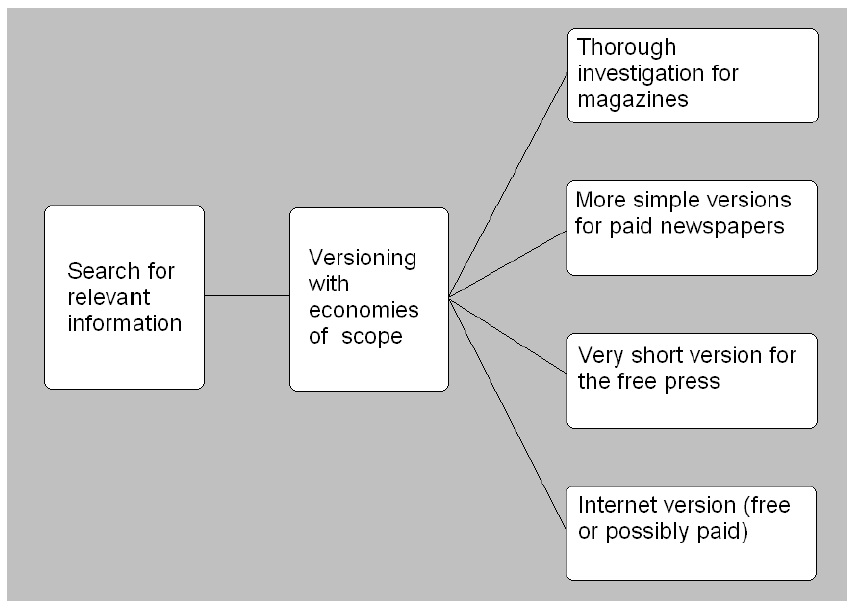All the changes that occurred due to the Internet have completely shaken the business models of the media industries. The actual period is still a transition phase. The business models have evolved through the years and now it is time to change again. In their article The Dynamics of Media Busniess Models: Innovation, Versioning and Blended Media Patrick-Yves Badillo and Dominique Bourgeois present their version of what could be a successful business model for the press. This section is based on their article and presents the findings and discoveries made by the two professors.
Before they introduce their business model the authors go back to the one that emerged recently, the low-cost model. This model is asserted in the media “by externalizing every administrative activity and never spending more than necessary.”(67) This model has emerged with new media and Internet. But it cannot work in the long term according to the article: “”the low-cost model which has been the solution of the very early twenty-first century will perhaps no longer be the best solution in years to come.”(68) Before presenting their solution they make sure to asses that the future is very difficult to predict: “…we must keep in mind that it is very difficult to make predictions about the future of the press industry in general…”(69)
The main theme of what the authors think will be the model of the future is versioning and blended media. They explain versioning in the following text:
“It means offering your information product in different versions for different market segments. In many ways, selling information on-line and off-line is like selling physical products through two separate channels of distribution […] the key question to ask yourself is whether the on-line version is a complement or a substitute for the off-line version. If it is a substitute for the off-line version, then you‟ll want to charge for it, recovering costs through fees or advertising or version it so that it doesn‟t directly compete with your off-line version. If it complements your off-line version, they you want to promote it as aggressively as possible, since it adds to the bottom line by encouraging sales of the off-line product.” Badillo and Bourgeois, p.80-81
They continue by declaring that a versioning strategy could be based on branding. The traditional press can use their brand to their advantage. The evocation of some newspapers rhymes with quality contents.
Those newspapers can extend that reputation to the new versions of products they bring to the market so these new versions are associated with the positive status of the old products. This would be really helpful for newspapers that want to enter a new market.
Badillo and Bourgeois follow their argumentation by reminding that the old model of the press was “characterized by strong economies of scale (as a result of the very high capital costs), with a situation of local monopoly where the law of proximity was fundamental, with a logic of quasi-fordist production.”(70) But the new model will be different from that. It “will be based on versioning, in a context where the economies of scope will be fundamental. Indeed an integration of the markets makes it possible to exploit at most the profitability of a production on various segments.”(71) That is illustrated in the graphic below:
(72)

It is clear that information costs a lot to be produced but it is easy to reproduce it. This graphic shows how media can be successful by expanding to a multimedia strategy on different platforms.
Badillo and Bourgeois continue by telling that “the concrete strategies of media firms will be various and according to different economic and social environments. Probably some firms will merge, some other will disappear, some will develop.”(73)
These arguments lead to the term of “blended” media that was chosen by Badillo and Bourgeois. They add that the quality of the production of information and the ability to offer a variety of versions on a variety of channels will be crucial. For the authors old media should not try to beat new media but rather merge together to become stronger. “The best dynamic businesses model will be able to take advantage of any new way to diffuse and to consumers / users (for example, to take advantage of social networks and so on).”(74)
So these are the key parameters of a model for the press. Its main objective is being able to use new media to the advantage of the old media to create together a stronger unit rather than the old media trying to challenge new media. “The blended media model is defined by the capacity to exploit in a continuous way the same information according to a multimedia differentiation and the most powerful possible versioning.”(75)
67 Badillo and Bourgeois, p.66
68 Badillo and Bourgeois, p.75
69 Badillo and Bourgeois, p.68
70 Badillo and Bourgeois, p.81
71 Badillo and Bourgeois, p.81
72 Badillo and Bourgeois, p.82
73 Badillo and Bourgeois, p.82
74 Badillo and Bourgeois, p.84
75 Badillo and Bourgeois, p.84
Page suivante : 8.1.2. Eventuality of abandoning the print form for the newspapers
